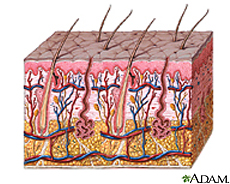 |
 |
 |
||
    |
||||
|
||||
|
Other Health Topics:
Moles
Also called: Nevus
Moles are growths on the skin. They happen when cells in the skin, called melanocytes, grow in a cluster with tissue surrounding them. Moles are very common. Most people have between 10 and 40 moles. A person may develop new moles from time to time, usually until about age 40. Moles are usually pink, tan or brown. They can be flat or raised. They are usually round or oval and no larger than a pencil eraser. About one out of every ten people has at least one unusual (or atypical) mole that looks different from an ordinary mole. The medical term for these unusual moles is dysplastic nevi. They may be more likely than ordinary moles to develop into melanoma, a type of skin cancer. Because of this, you should have a healthcare professional check your moles if they look unusual, grow larger, change in color or outline, or in any other way. National Cancer Institute
Start Here
|
| Home | Health Topics | Drugs & Supplements | Encyclopedia | Dictionary | News | Directories | Other Resources | |
| Disclaimers | Copyright | Privacy | Accessibility | Quality Guidelines U.S. National Library of Medicine, 8600 Rockville Pike, Bethesda, MD 20894 National Institutes of Health | Department of Health & Human Services |
Date last updated: 08 April 2009 Topic last reviewed: 10 December 2008 |


